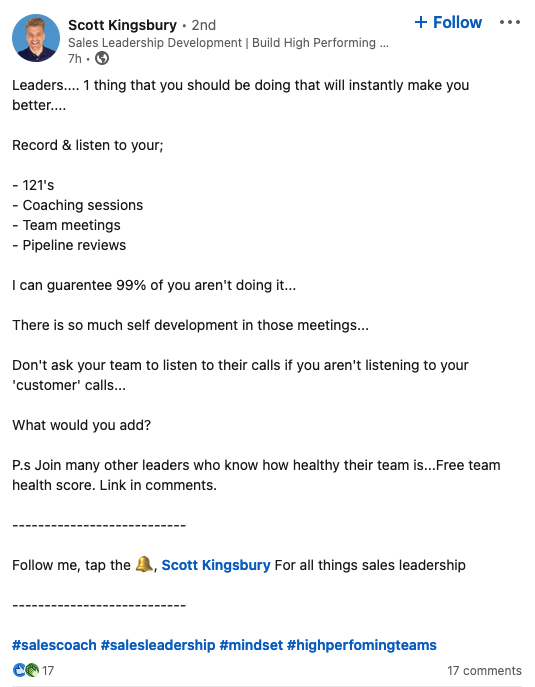Table of Contents
Share this article
Learn from the brightest minds how to predictably and efficiently grow revenue.
Related Content
5 Ways to Use the Ebsta Integration With HubSpot to Improve Sales Performance
How to improve adoption of HubSpot with Ebsta
B2B Sales Benchmarks: 2023 H1 Update
The latest update from the 2023 B2B Sales Benchmarks analysis of over $37bn in pipeline.
How to improve AE quota attainment (according to data)
23% of reps are contributing 83% of revenue. Here's how to solve it (with data)
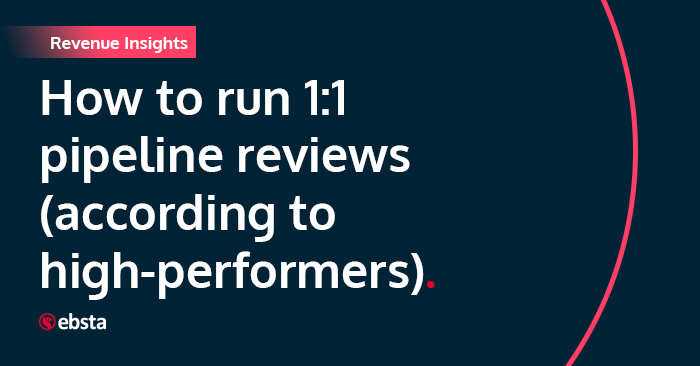
How to Run Pipeline Reviews (according to high-performing sales teams)
Pipeline reviews, love them, or hate them, are a vital fixture in a salesperson’s week. Done well, they are an opportunity for guidance, reflection, and improvement. Done poorly, they waste time, create frustration, and can leave reps feeling alienated.
Pipeline reviews tread a fine line between helping a rep to make quota or creating friction through micromanagement. Leaders and managers are responsible for ensuring the former and running a 1:1 that AEs get value from every week.
The best pipeline reviews provide reps with clarity of what deals to prioritize, what to do to push deals forwards, and who to engage to increase the chances of the deal closing. The worst pipeline reviews spend half the time ‘catching up’, leave reps with uncertainty of what to do next and end with reps making decisions based on their own gut feel.
There are four requirements to set pipeline reviews consistently up for success. First, focus on outcomes instead of opinions. Second, base decisions on facts instead of a gut feeling. Lastly, to set clear next steps that both the manager and the rep are aligned on by the end of the meeting.
1. Remove friction with insight into how deals are progressing
Opinion and conjecture can often limit the effectiveness of pipeline reviews. Many deals look the same on the surface – but the manager and rep will frequently have different perspectives. This difference in opinion leads to plenty of time being spent just getting on the same page – instead of focusing on progressing a deal forward.
It is too easy to get lost in “Tell me more about deal X” and “What is happening with deal Y.” Lack of visibility into the deal means decisions are made based on a rep’s somewhat biased perspective.
Using deal insights offers managers and reps the facts to support an opinion. Deal insights benchmark historical performance to identify risk. For example, leveraging historical analysis of how long deals spend in the ‘proposal’ stage to identify deals that are ‘stuck’ in stage (i.e have exceeded the average length of time).
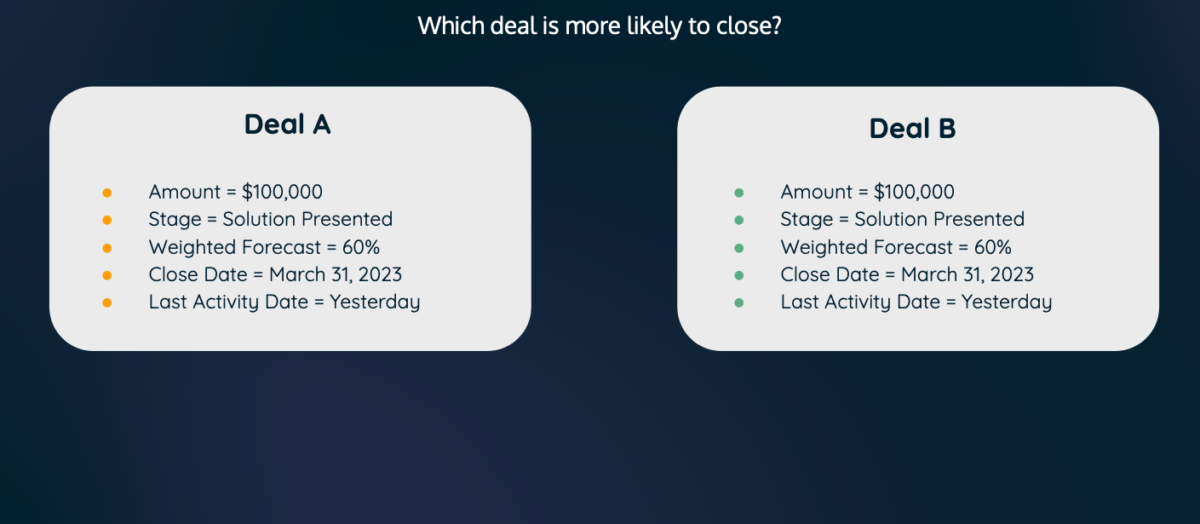
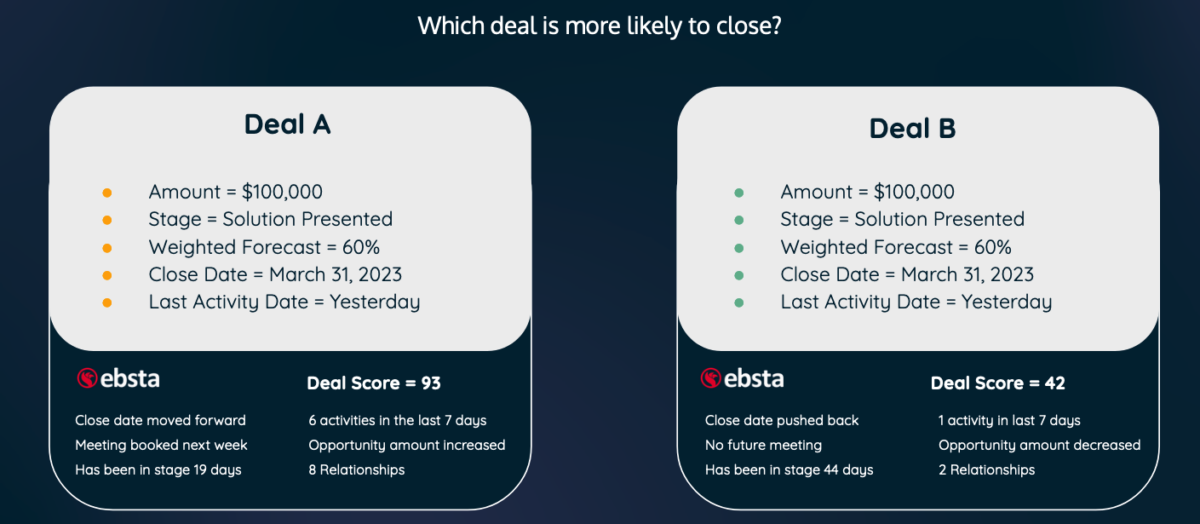
These insights give sales teams an objective view of what is happening in a reps’ pipeline based on their (or their team’s performance). This enables conversations to focus on matters of fact, rather than opinion.
These insights combined with reporting give an overview of the health of a rep’s pipeline before the meeting. Beforehand, this allows the manager and rep to review objectively. For a manager, this means they can see the state of the reps’ deals through a non-biased lens. As a result, they are spending far less time trying to understand opportunities. Instead, they can easily digest how deals are progressing, see the latest activity, and identify opportunities for coaching.
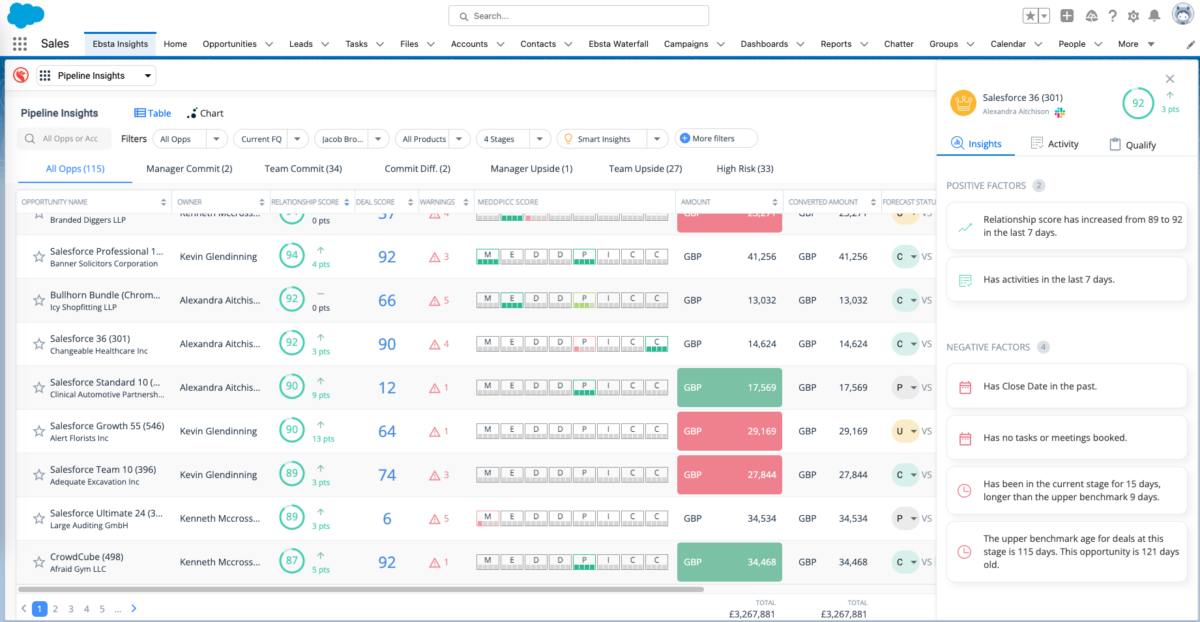
Then when it comes to the 1:1 review, it’s a genuine discussion about what deals are trending negatively (i.e. deal amount has decreased, close date pushed back), which are at risk, and how the rep intends to push them forward. As a result, discussions focus on outcomes rather than dwelling on what has happened previously.
It also allows managers and reps to overcome the recency and cognitive bias that often plague review meetings. Without deal insights, it’s easy for pipeline reviews to focus on deals a rep is feeling positive about, and to looks at it through the reps’ perspective. By incorporating deal insights – manager and rep can review pipeline objectively and without bias.
2. Results require consistency – and patience
Pipeline reviews exist to help both reps and managers to achieve their goals – hitting quota (both at a rep and team level). Success will require more than a single meeting. The benefits only begin to become apparent with consistency. The 1:1 review should be a staple in the rep’s calendar: the same day and time every week.
Set a convenient time that does not overlap selling hours, which both can make each week. 1:1s are non-negotiables. The benefits of consistent pipeline reviews will only emerge gradually as the quarter progresses.
Once in the meeting, the focus on consistency continues. Use the same agenda, prioritize the same metrics, and prioritize outcomes (more on this below). This structured approach limits distractions, allows for week-on-week comparisons to track performance and removes bias from the equation.
Every manager and rep follows the same agenda (see step 3). This ensures spending time on progressing stalled deals and ensuring deals at risk are being prioritized.
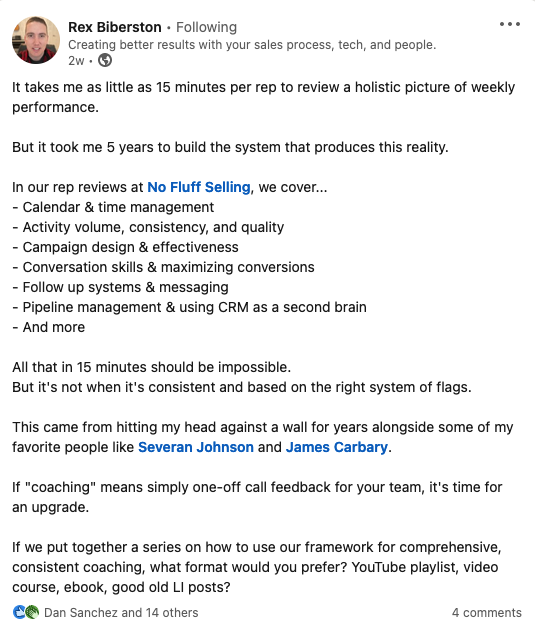
3. Prioritize the deals that matter most with an agenda
Agendas provide a framework for every review to follow. Not only does this create consistency between one manager and rep – it creates consistency across sales teams.
Without one, the direction of the meeting is at the whims of the individuals involved. It can become easy to drift into chatter or issues unrelated to the overall goal. The pipeline review aims to discuss how the rep will achieve their quota this quarter. Without an agenda, it becomes all too easy to take your eye off this goal and spend your time discussing deals that may not be the most important.
Example agenda:
- What deals have trended negatively or remained idle?
- What deals are at risk? Why?
- Why will we win this deal? Have we proved that we will solve the prospect’s problems?
- How do we plan to close this deal?
- When will it close? What is the trigger to buy on a specific date? What is our proof?
- Whom do we need to influence? Do we have the right decision-maker and economic buyer?
- What new opportunities have been created? Have they been qualified?
For the agendas that high-performing sales teams use to review current, next and historical pipeline – download the forecast cadence.
Ultimately, it is the responsibility of the sales leader to define what deals are most important, and therefore what the agenda is to ensure those deals are prioritized.
The example format has deals at risk and stalling at the top. It then follows up with clear actions to define the way forward. It also considers qualifying criteria, enabling constructive discussions using the original criteria from when the opportunity was first accepted into the rep’s pipeline.
An agenda such as this aims to guide discussions toward priority deals and how to move them forward. It drives them away from laying blame when things are not going as planned – instead, it focuses on how to get them back on track.
It also becomes more of a constructive exercise. Insights (such as deals in stage for too long, or lack of stakeholders compared to previous deals) clarify what is happening to both sides – thereby equipping both individuals with the information they need to support their case when disagreements arise.
4. Support decision-making with evidence (data)
For pipeline reviews to be successful – alignment when making decisions is essential. When committing to the next step or submitting a forecast, differing opinions are inevitable. When opinions differ, this leads to friction, and given time, conflict can lead to a breakdown in the relationship between manager and rep.
A better way to bridge these inevitable differences is to use insights when decision-making. Let’s take forecast submission as an example. The rep has a deal set to close in the last week of the quarter with seven days to go. They have the deal committed to the forecast. However, when reviewing their pipeline beforehand, the manager spots that no meetings are booked, and the last activity was over a week ago.
Immediately, there are clear red flags here.
Of course, there is a good chance the rep will have perfectly valid reasoning for this. The difference now is that managers have visibility of deals potentially at risk. Meanwhile, AEs now have access to information to support their decision.
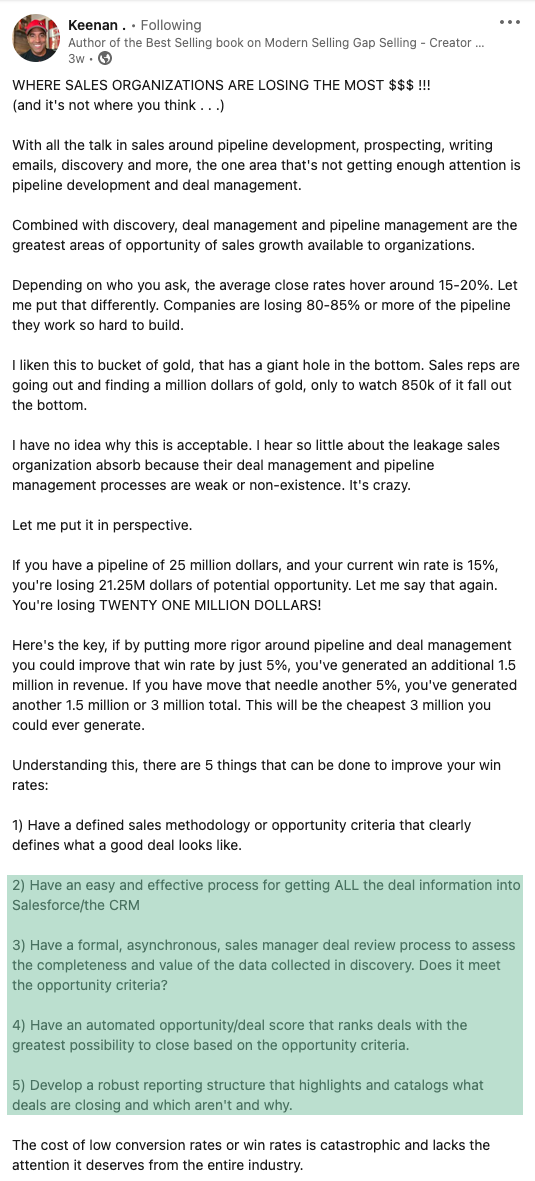
With a format that pushes priority deals to the top of the agenda, critical decisions, such as the next step and forecast call, can be made with insights to support an agreed-upon decision.
Pushing priority deals to the top of the agenda enables more effective critical decision-making. Decisions such as the next step and forecast call can now be made with insights to support the decision. There are no longer made in isolation. Instead, they are reached by consensus using activity data to support the decision made.
A framework you could use would follow these 9 steps:
- Create a regular cadence for pipeline reviews to take place
- Set a consistent agenda that suits your sales process (such as the one above)
- Keep your CRM up-to-date with recent activity
- Turn activity into insights to show the health of deals
- Have managers and reps spend 30 minutes before the meeting reviewing the health of their pipeline
- Prioritize meeting time on high-priority opportunities first
- Ensure clear outcomes are achieved by the end of the meeting
- Ensure decisions are made with evidence to support each (from activity, qualification criteria etc)
- Record pipeline reviews so sales leaders can help managers to execute pipeline reviews with reps better
At the end of each review, both manager and rep should leave having agreed on a clear path forward for the most important deals.
Bonus step:
Through the meeting, for rep and manager, opportunities for coaching will inevitably arise. It may be due to specific reasons why certain deals stalled. It may be how to navigate certain hurdles in closing a deal. It could be how to handle a situation when both parties disagree.
Pipeline reviews play a key role in a sales team’s week. Therefore, for sales leaders, there is the opportunity to level up a manager’s skills by providing feedback on their reviews.
